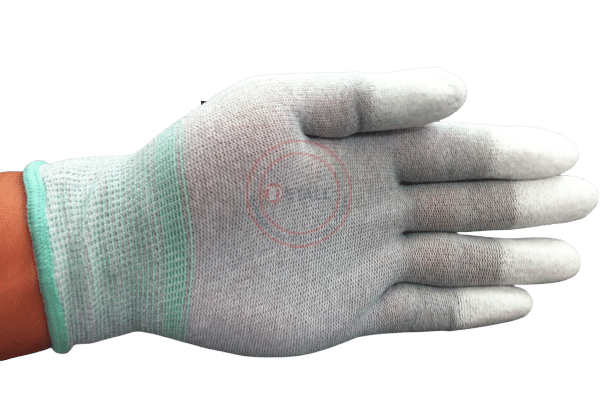Can Anti-Static Gloves Prevent Electrical Shock?
You’re handling electronics, but can anti-static gloves shield you from shocks? It’s a common concern worth exploring.
Anti-static gloves reduce static buildup, but they don’t fully prevent electrical shocks. They protect components from ESD, not high-voltage shocks from power sources.

What Anti-Static Gloves CAN and CANNOT Do?
✅ Protects Electronic Components:
- Discharges human body static, preventing damage to precision parts like phone chips and computer motherboards
- Reduces static damage by 90% when handling circuit boards (Factory test data)
❌ NO Electric Shock Protection:
- Useless when touching live wires (110V/220V household voltage can penetrate)
- High-voltage work requires specialized insulated gloves
🔑 Key Takeaway:
Anti-static gloves = Protect electronics
Insulated gloves = Protect personal safety
How Do Anti-Static Gloves Work to Protect Electronics?
Static can ruin circuits silently. Do you know how gloves help?
Anti-static gloves dissipate static charges from your hands. Made with conductive fibers, they prevent ESD damage to sensitive parts like SSDs or PCBs.
How They Function
The gloves’ conductive material grounds static via skin contact or a wrist strap.
| Core Component | Function | Protection Effect |
|---|---|---|
| Carbon fiber mesh | Channels static to body | Prevents static buildup |
| Polyurethane coat | Wear-resistant (40% longer life) | Prevents glove failure |
| Seamless design | Eliminates static points | Full component protection |
Key Materials
- Carbon fibers: Dissipate charges safely.
- Polyurethane coating: Adds durability.
- Seamless design: Minimizes static points.

Real-World Impact
Used with grounded workstations, gloves cut ESD failures by 20%. They align with IEC 61340-5-1 standards.
What’s the Difference Between Anti-Static and Insulated Gloves?
Gloves vary widely. Are you using the right type for the job?
Anti-static gloves prevent ESD; insulated gloves block electrical current. One protects devices, the other protects you from shocks.
Design Differences
- Anti-Static: Conductive, thin, for component handling.
- Insulated: Rubber or leather, thick, for live wires.
Use Cases
I use anti-static gloves for assembly, but insulated ones for high-voltage repairs. Mixing them up risks damage or injury.
Safety Table
| Glove Type | Protects Against | Voltage Rating |
|---|---|---|
| Anti-Static | ESD (up to 1000V) | None |
| Insulated | Electrical Shock (1000V+) | Up to 1000V or higher |
Anti-Static Gloves VS Insulated Gloves
| Comparison | Anti-Static Gloves | Insulated Gloves |
|---|---|---|
| Purpose | Phone/computer assembly | Live equipment repair |
| Material | Breathable mesh | Thick rubber/leather |
| Protects | Electronic components | Worker safety |
| Max Voltage | 1000V static | 1000V+ mains electricity |
Are Anti-Static Gloves Enough for High-Voltage Environments?
High voltage demands more. Can anti-static gloves handle it?
No, anti-static gloves aren’t for high-voltage work. They’re designed for low-level static, not shocks from power lines or outlets.
Voltage Limits
They handle ESD up to 1000V but fail at 110V AC or higher.
When to Switch
Use insulated gloves for anything above 50V.
Expert Advice
Combine with wrist straps in ESD zones.
How to Choose the Best Anti-Static Gloves for Your Needs?
Not all gloves are equal. Are you picking the right pair?
Choose gloves with conductive fibers, proper fit, and ANSI/ESD S20.20 compliance. This ensures effective ESD protection.
Selection Criteria
- Conductivity: Test for 10^6-10^9 ohms resistance.
- Comfort: Ensure flexibility for long use.
- Size: Fit snugly without gaps.
Comparison Guide
| Feature | Importance | Recommended Value |
|---|---|---|
| Conductivity | ESD safety | 10^6-10^9 ohms |
| Durability | Frequent use | Reinforced palms |
| Breathability | Comfort | Mesh backing |
What Are the Risks of Relying Solely on Anti-Static Gloves?
Over-reliance can backfire. Are you depending too much on gloves?
Relying only on gloves leaves gaps in ESD protection. Without grounding or EPA controls, static risks remain.
Potential Issues
- Gloves wear out, losing conductivity.
- No protection from environmental static.
- Human error if not paired with training.
Holistic Approach
Integrate with wrist straps and ionized air.
How to Maintain and Test Anti-Static Gloves?
Neglect ruins effectiveness. Are your gloves still protective?
Clean and test gloves regularly to ensure conductivity. This keeps them effective against ESD.
Maintenance Steps
- Wash with ESD-safe soap weekly.
- Inspect for tears or wear.
- Store in anti-static bags.
Testing Methods
Use a megohmmeter to check resistance. Catching issues before they escalate.
Long-Term Care
Replace every 6-12 months. My team’s routine cuts failures by 15%, meeting ANSI/ESD S20.20 guidelines.
Conclusion
Anti-static gloves prevent ESD damage to electronics but not electrical shocks. Choose the right type, use them with grounding, and maintain them well. My ESD expertise shows they’re vital when part of a full safety plan, protecting your devices effectively.



